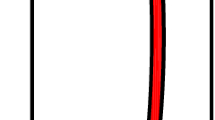Abstract
In this paper, a new weak condition for the convergence of secant method to solve the systems of nonlinear equations is proposed. A convergence ball with the center x 0 is replaced by that with x 1, the first approximation generated by the secant method with the initial data x −1 and x 0. Under the bounded conditions of the divided difference, a convergence theorem is obtained and two examples to illustrate the weakness of convergence conditions are provided. Moreover, the secant method is applied to a system of nonlinear equations to demonstrate the viability and effectiveness of the results in the paper.
Similar content being viewed by others
References
Argyros I K. Improved convergence analysis for the secant method based on a certain type of recurrence relations, Int J Comput Math, 2004, 81(5): 629–637.
Balázs M, Goldner G. On existence of divided differences in linear spaces, Rev Anal Numér Théorie Approximation, 1973, 2: 5–9.
Dennis J E. On the convergence of Newton-like methods, In: Numerical Methods for Nonlinear Algebraic Equations, London: Gordon and Breach, 1970.
Han Danfu, Wang Xinghua. Convergence on a deformed Newton method, Appl Math Comput, 1998, 94: 65–72.
Hernández M A, Rubio M J. The secant method and divided differences Hölder continuous, Appl Math Comput, 2001, 124(2): 139–149.
Huang Zhengda. On the convergence of the secant method in Banach space, J Zhejiang Univ (Science) (in Chinese), 2002, 29(2): 140–143.
Liang Kewei. Theories and methods for solving nonlinear equations and its applications in singularly perturbed problems, PhD Thesis, Hangzhou: Zhejiang University, 2001.
Potra F A. On iterative algorithm of order 1.839 ... for solving nonlinear operator equations, Numer Funct Anal Optim, 1984–85, 7(1): 75–106.
Potra F A, Ptak V. Nondiscrete Induction and Iterative Processes, New York: Pitman, 1984.
Ren Hongmin, Yang Shijun, Wu Qingbiao. A new semilocal convergence theorem for the secant method under Hölder continuous divided differences, Appl Math Comput, 2006, 182(1): 41–48.
Schröder J. Nichtlineare Majoranten beim Verfahren der schrittweisen Nädherung, ArchMath, 1956, 7: 471–484.
Wang Xinghua. Convergence of an iterative procedure, Chinese Science Bulletin, 1975, 20(12): 558–559.
Wang Xinghua. On error estimates for some numerical root-finding methods, Acta Math Sinica, 1979, 22(5): 638–642.
Wang Xinghua. On the Mysovskich theorem of Newton method, Chinese Ann Math, 1980, 1(2): 283–288.
Author information
Authors and Affiliations
Additional information
Supported by the Qianjiang Rencai Project Foundation of Zhejiang Province (J20070288).
Rights and permissions
About this article
Cite this article
Liang, Kw., Han, Df., Zhang, H. et al. A weak condition for secant method to solve systems of nonlinear equations. Appl. Math. J. Chin. Univ. 24, 90–96 (2009). https://doi.org/10.1007/s11766-009-1975-9
Received:
Published:
Issue Date:
DOI: https://doi.org/10.1007/s11766-009-1975-9



